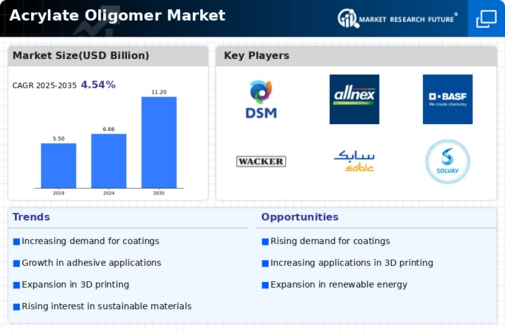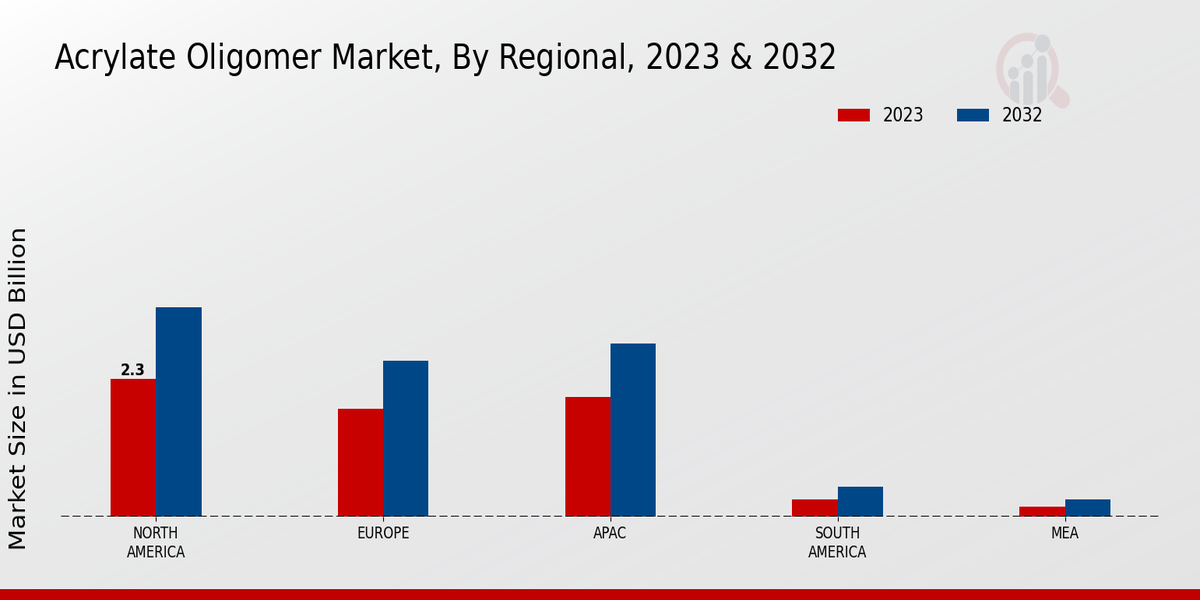Expansion of the Electronics Sector
The Global Acrylate Oligomer Market Industry is significantly influenced by the expansion of the electronics sector, which increasingly utilizes acrylate oligomers in various applications such as adhesives, coatings, and encapsulants. The proliferation of consumer electronics, including smartphones and tablets, drives the demand for high-performance materials that offer durability and aesthetic appeal. As the electronics market continues to grow, the demand for acrylate oligomers is expected to rise correspondingly. This growth is anticipated to contribute to the market's value, projected to reach 11.2 USD Billion by 2035, highlighting the critical role of acrylate oligomers in supporting technological advancements.
Growth in the Construction Industry
The Global Acrylate Oligomer Market Industry benefits from the growth in the construction sector, where acrylate oligomers are increasingly used in sealants, adhesives, and coatings. The ongoing urbanization and infrastructure development projects worldwide create a substantial demand for high-performance materials that can withstand harsh environmental conditions. As construction activities expand, particularly in emerging economies, the need for durable and efficient materials becomes paramount. This trend is likely to bolster the market, as acrylate oligomers provide essential properties such as adhesion, flexibility, and resistance to weathering, thus enhancing the overall performance of construction materials.
Increasing Demand for UV-Curable Coatings
The Global Acrylate Oligomer Market Industry experiences a notable surge in demand for UV-curable coatings, primarily driven by their rapid curing properties and environmental benefits. Industries such as automotive, electronics, and packaging increasingly adopt these coatings due to their efficiency and reduced volatile organic compound emissions. In 2024, the market is projected to reach 6.66 USD Billion, reflecting a growing preference for sustainable solutions. This trend is expected to continue, with a compound annual growth rate of 4.84% from 2025 to 2035, indicating a robust market trajectory as manufacturers seek to enhance product performance while adhering to stringent environmental regulations.
Rising Awareness of Eco-Friendly Products
The Global Acrylate Oligomer Market Industry is witnessing a shift towards eco-friendly products, driven by increasing consumer awareness and regulatory pressures. Manufacturers are compelled to innovate and develop sustainable acrylate oligomers that minimize environmental impact while maintaining performance standards. This trend is particularly evident in industries such as packaging and coatings, where the demand for low-VOC and non-toxic formulations is on the rise. As a result, companies are investing in research and development to create greener alternatives, which could potentially reshape the market landscape. This shift not only aligns with global sustainability goals but also opens new avenues for growth in the acrylate oligomer sector.
Technological Advancements in Polymer Chemistry
The Global Acrylate Oligomer Market Industry is significantly impacted by technological advancements in polymer chemistry, which enhance the performance and versatility of acrylate oligomers. Innovations in synthesis methods and formulations lead to the development of new products with improved properties, such as increased thermal stability and enhanced adhesion. These advancements enable manufacturers to cater to diverse applications across various industries, including automotive, aerospace, and healthcare. As technology continues to evolve, the market is likely to benefit from the introduction of novel acrylate oligomers that meet the specific needs of end-users, thereby driving growth and expanding market opportunities.























Leave a Comment